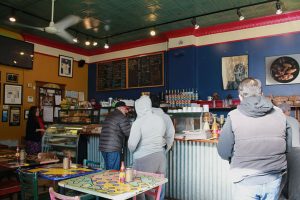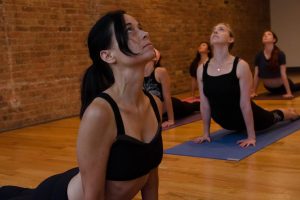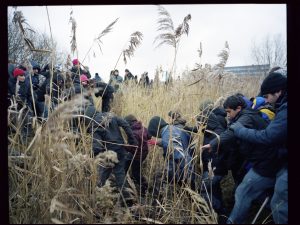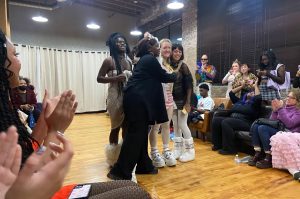
No matter how many times they come crashing down onto the pavement, they always get back up.
These are the skaters of Wilson Skate Park.
Roughly a half-acre space located off of Wilson Avenue next to the Lakefront Trail in the Uptown neighborhood, Wilson Skate Park is home to a majority of Chicago’s skateboarding population. The diversity directly reflects that of Uptown—ages ranging from as young as 4 to as old as 60, representations of all different races and ethnicities, from students to parents and men to women.
Throughout all hours of the day, passersby can hear the constant sound of boards and bodies hitting solid concrete and elevated metal rails, exasperated skaters trying to land that one desired trick and the individual shout-outs of recognition from each skater for a fellow member of their group who finally pulled it off.
Amid the sea of ripped jeans, scabbed elbows and worn out skateboards, one can notice the underlying atmosphere of Wilson Skate Park: dedication, passion and camaraderie.
This isn’t a place of rebellion or an active counter-culture. This is a place of art.
Gabriel Allen, owner of Wilson Yards Skate Shop on Wilson Avenue, said there is still the misconception that skateboarders are compiled of a group of punks.
In truth, he said, skaters get into a lot less trouble than other kids. He continued that when someone decides to start skating, they enter into a community and are given a sense of belonging where everyone gets along.
In a city where skateboarding in public areas, streets and sidewalks is often illegal and frowned upon, and free, open skate parks are few and far between, parks like Wilson Skate Park are a safe haven for skaters. For Uptown, specifically, the park provides an opportunity for youths to focus their energy on something productive and stress relieving in order to stay active, healthy, and most importantly, safe.
Allen said that in a neighborhood like Uptown, where violence and gang activity are common, the skating community can help save kids from wandering down the wrong path.
“When we see young kids on the corner, we give them a skateboard,” Allen said.
Randy Johnson, manager of Citizen Skate Café on Wilson Avenue just a few blocks west of the skate park, said that Uptown has a history of fostering the skating community.
Back before the skate park was built in 2003, Johnson said that Jesus People USA, the non-profit organization that owns Citizen Skate Café, used to have homemade ramps in backyards for the neighborhood kids to skate on.
In 2009, Johnson and a few others had the idea of opening a skate shop to cater to the skating community coming out of Wilson Skate Park, but made the decision to combine coffee and skateboarding as a way to mix the skaters with the rest of the public.
Hannah Wright, a barista for Citizen Skate Café, said it’s not uncommon to have men in business suits sitting next to a group of young kids who just returned from the skate park, interacting with one another.
This “community outreach” hasn’t always been associated with skateboarding.
Allen said that at one time skaters’ rebellious stereotype was closer to reality. People who may have been on the fringe or considered “on the outside” were more prone to buy into the skateboarding culture, he said.

When Allen first started skating with his friends back in the ’70s, there was no where else to go except parking lots, the steps of a bank or sidewalks and streets. He said that skaters are more drawn to places where they are told they were not supposed to skate, giving off the impression that the skating community was more of a social liability.
Johnson painted a similar picture. Growing up in California, where skateboarding originally got its start as “sidewalk surfing,” Johnson said skateboarders belonged to an entirely different culture. Those who were living out west during the birth of skateboarding were able to drain a pool to ride in and had hills to cruise down.
Skaters in Chicago were limited to street skating, practicing their craft anywhere and on anything they could find, but Allen said that this allowed more for the skater’s imagination.
However, Allen said the industry of skateboarding has changed. The skateboarding scene in Uptown and Chicago as a whole is so diverse that there is no longer a monolithic definition of who skaters are or what they look like.
Outside of the city, however, Allen said one could find the “stereotypical” skateboarder: numerous tattoos, gauges in their ears and an extreme territorial attitude. But in the city, Allen said, this label ceases to exist.
Lou Shields, a 38-year-old artist and musician, has been skating in Chicago since the ’80s.
“Some people view us as delinquents,” Shields said. “Really, kids found an outlet for whatever is wrong with their lives…some kids are here geniuses.”
The mixture of multiple generations at places like Wilson Skate Park bring the skateboarding culture down to one thing, Shields said: respect.
“Skating ties us all together,” Shields said. “We have drug addicts to lawyers out here.”
Younger skaters have a different idea of what skating is compared to the older generations, and Shields said that the veterans are often setting an example for the younger crowd.
Allen said that many of the younger skaters have a much different attitude towards the sport than more seasoned skaters, and a lot of this has to due with the immediacy instilled in the country’s youth today as far as “making it big.”
One thing still bridges the gap between the two: the passion for skating.

Vlad Stashis, 26, has been skating for about 16 years. He said he wasn’t into team sports much growing up and didn’t like being coached. The independence of skateboarding is what drew him in.
Stashis said everybody skates for their own fun, and it’s an unwritten rule that everyone looks out for each other. The skating community wants everyone to succeed and enjoy themselves, he said.
Shields was hesitant to label skateboarding as a sport at all.
“I’m an artist; it’s a form of expression,” Shields said about skateboarding. “I get sick if I don’t do it.”
Allen said that the dedication to the sport is what makes skating so unique. What people might not realize, Allen said, is that skaters endure damage to their bodies just as much as a professional football player does.
For skaters, it doesn’t matter how many times they fall, and they will repeatedly attempt the same move for hours on end until they get it exactly right, Allen said.
“Skateboarding is like flying without leaving the ground,” Allen said. “It’s freeing– there’s nothing like it.”

















Be First to Comment